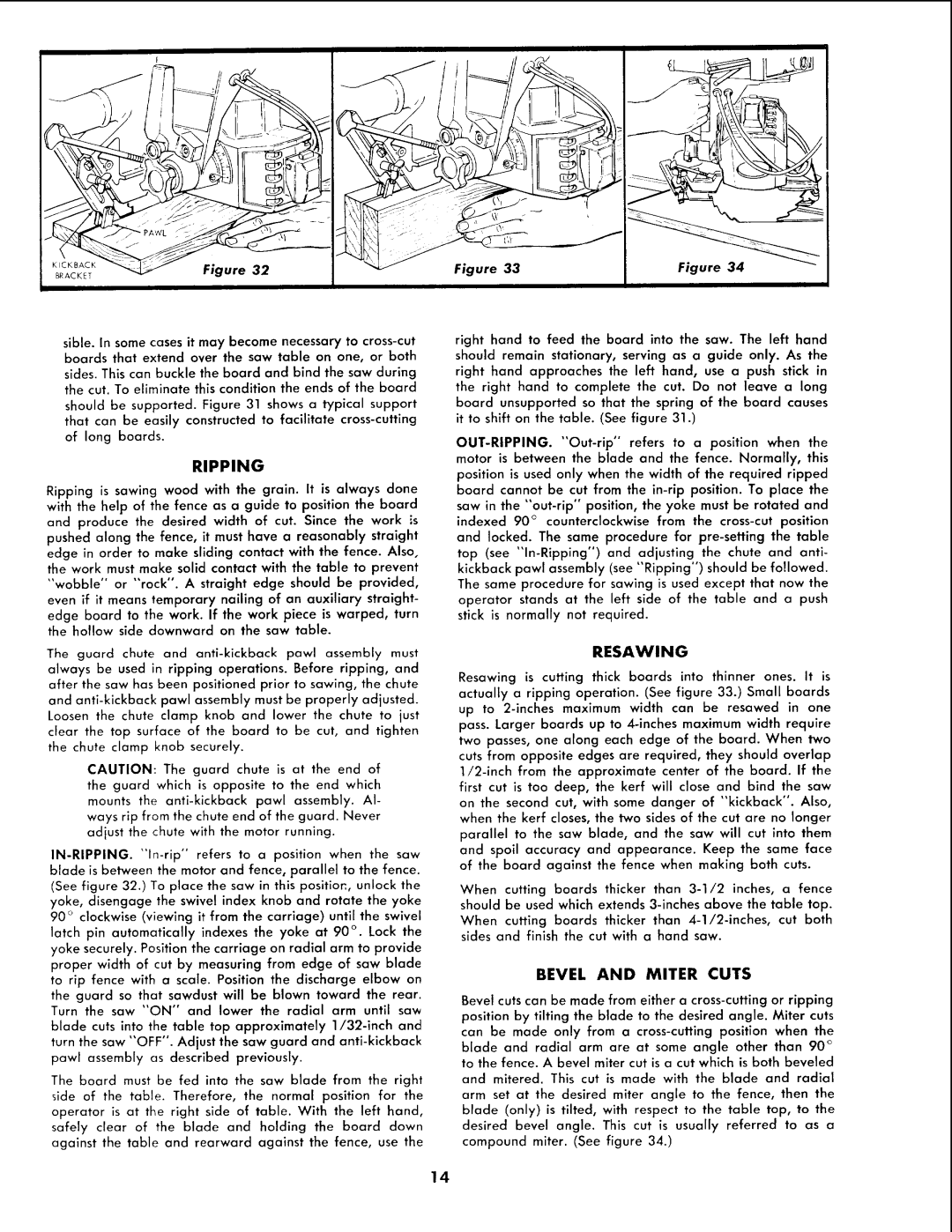sible. In some cases it may become necessary to cross-cut boards that extend over the saw table on one, or both sides. This can buckle the board and bind the saw during the cut. To eliminate this condition the ends of the board should be supported. Figure 31 shows a typical support that can be easily constructed to facilitate cross-cutting of long boards.
RIPPING
Ripping is sawing wood with the grain. It is always done with the help of the fence as a guide to position the board and produce the desired width of cut. Since the work is pushed along the fence, it must have a reasonably straight edge in order to make sliding contact with the fence. Also, the work must make solid contact with the table to prevent "wobble" or "rock". A straight edge should be provided, even if it means temporary nailing of an auxiliary straight- edge board to the work. If the work piece is warped, turn the hollow side downward on the saw table.
The guard chute and anti-kickback pawl assembly must
always be used in ripping operations. Before ripping, and after the saw has been positioned prior to sawing, the chute
and anti-kickback pawl assembly must be properly adjusted. Loosen the chute clamp knob and lower the chute to just clear the top surface of the board to be cut, and tighten the chute clamp knob securely.
CAUTION: The guard chute is at the end of the guard which is opposite to the end which
mounts the anti-kickback pawl assembly. Al- ways rip from the chute end of the guard. Never adjust the chute with the motor running.
IN-RIPPING."In-rip" refers to a position when the saw blade is between the motor and fence, parallel to the fence. (See figure 32.) To place the saw in this positior., unlock the yoke, disengage the swivel index knob and rotate the yoke 90 ° clockwise (viewing it from the carriage) until the swivel latch pin automatically indexes the yoke at 90 ° . Lock the yoke securely. Position the carriage on radial arm to provide proper width of cut by measuring from edge of saw blade to rip fence with a scale. Position the discharge elbow on the guard so that sawdust will be blown toward the rear. Turn the saw "ON" and lower the radial arm until saw blade cuts into the table top approximately 1/32-inch and turn the saw "OFF". Adjust the saw guard and anti-kickback pawl assembly as described previously.
The board must be fed into the saw blade from the right side of the table. Therefore, the normal position for the operator is at the right side of table. With the left hand, safely clear of the blade and holding the board down
against the table and rearward against the fence, use the
right hand to feed the board into the saw. The left hand should remain stationary, serving as a guide only. As the right hand approaches the left hand, use a push stick in the right hand to complete the cut. Do not leave a long board unsupported so that the spring of the board causes it to shift on the table. (See figure 31.)
OUT-RIPPING. "Out-rip'* refers to a position when the motor is between the blade and the fence. Normally, this position is used only when the width of the required ripped board cannot be cut from the in-ripposition. To place the saw in the "out-rip" position, the yoke must be rotated and indexed 90 ° counterclockwise from the cross-cut position and locked. The same procedure for pre-setting the table top (see "In-Ripping") and adjusting the chute and anti- kickback pawl assembly (see "Ripping") should be followed. The same procedure for sawing is used except that now the operator stands at the left side of the table and a push stick is normally not required.
RESAWlNG
Resawing is cutting thick boards into thinner ones. It is actually a ripping operation. (See figure 33.) Small boards up to 2-inches maximum width can be resawed in one pass. Larger boards up to 4-inches maximum width require
two passes, one along each edge of the board. When two cuts from opposite edges are required, they should overlap 1/2-inch from the approximate center of the board. If the
first cut is too deep, the kerf will close and bind the saw on the second cut, with some danger of "kickback". Also, when the kerf closes, the two sides of the cut are no longer
parallel to the saw blade, and the saw will cut into them and spoil accuracy and appearance. Keep the same face of the board against the fence when making both cuts.
When cutting boards thicker than 3-1/2 inches, a fence should be used which extends 3-inches above the table top. When cutting boards thicker than 4-1/2-inches, cut both sides and finish the cut with a hand saw.
BEVEL AND MITER CUTS
Bevel cuts can be made from either a cross-cutting or ripping
position by tilting the blade to the desired angle. Miter cuts can be made only from a cross-cutting position when the blade and radial arm are at some angle other than 90 ° to the fence. A bevel miter cut is a cut which is both beveled and mitered. This cut is made with the blade and radial arm set at the desired miter angle to the fence, then the
blade (only) is tilted, with respect to the table top, to the desired bevel angle. This cut is usually referred to as a
compound miter. (See figure 34.)

